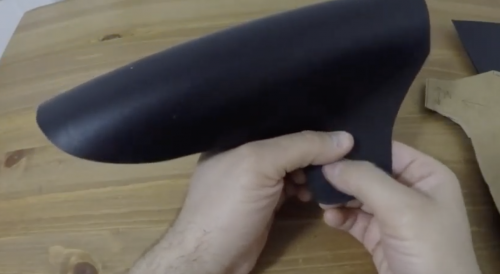Most people who ride a fat bike understand the importance of having a fender and mudguards when riding on certain terrains. It can get pretty messy without them, and it also slows down some rides if too much water, mud, and other debris kicks up.
The problem is, not all people want to go out and make a huge investment in buying a fat bike fender or mud guard to add to the growing list of add-ons. The good news is that people do not have to necessarily go that route, as these are pretty easy to make specifically for a bike.
Does a person need to be extremely handy? The instructions are very easy, and there is some leeway as far as what material to work with as well. It is a pretty inexpensive project, so even in the worst-case scenario, people who do not ultimately like what they finished with can either try again or go out and invest in something that is pre-made.
Before getting started, here are a few notes on materials, cost, tours, and more. After that, a closer look at the process breaks down how to accomplish this DIY project.
Overall Cost
It is going to cost the average person about $15 to make a bike fender or mudguard set for a bike. This is mostly the cost to buy the material, as it is assumed people have some essential tools and time available to put things to work.
Anyone who can’t afford to make a few purchases should start budgeting to get to that point. It is going to be more expensive to go out and make a purchase, so learning about the process is the way to save a little money.
What to Buy
To make the easiest fenders and mudguards, it is important to start with these materials as a bare minimum.
- Two aluminum flat bars (48” length, width dependent on the size of the tires)
- Allen head bolts (six total, size 5 mm)
- Flat washers (12 is standard for most fat bikes)
- Utility wire (10-15 feet)
- Cable clamps (four of them, size 1/16”)
- L-angle bracket
- 2 inch bolt
Tools
Only basic tools are needed to pull off this do-it-yourself project. The tools people are most likely not to have at their home include a hacksaw and a drill.
If there is one not available, and no one can loan either of these tools for a limited time, try to rent them at a local hardware store. It usually does not cost that much money, and there is really no need to rent them for longer than a few hours for a project like this.
As for pretty standard tools, make sure to also have:
- Marker
- Clamp
- Flat file
- Pliers
- Allen wrench
- Screwdriver
Breaking Down the Process
Now that everything is purchased and ready to go, it comes down to finally getting to work. There are different major parts of the project, and getting them right might take a little tweaking at first. Most people can get something that works, and that is beneficial in the end.
STEP 1 – Prepping the fenders and guards
The first step is to remove any of the wheels from the bike that will be fitted for a fender or mudguard. Most people start with a rear wheel, but doing both is perfectly fine as well. The wheel is a perfect guide to shape the fender and create a curve that works.
Wrap the aluminum around the rim of the tire to start getting an idea on the curve. Once that is determined, start running the metal back-and-forth on a surface to get the curve to hold as a person wants. The tire can be put to the side after this. Later on, the tire will need to go back so that alignment is properly checked.
Ideally, rear fenders should cover about half of the wheel if done correctly. That comes out to about 48 inches for the biggest tires out there, but there will be a need to remove some length if the tires are smaller.
For front fenders, only about 1/4 of the tire needs covered. For an exact measurement, simply cut both pieces to the same length for the rear, and then cut the second in half for front coverage.
What people notice is that the end of the fenders might not look all that great. No one wants sharp edges on the fender, so smoothing out the end is the best way to go.
Use any type of round object that is long enough to cover the ends to get a proper measurement. Smooth out the rough edges, and everything should be good from there.
STEP 2 – Attaching the Fenders
Now that the fenders are created, attaching is the biggest issue. The rear fender is generally considered the tougher of the two tasks, but both do not take that much time as long as people know a general idea of what they are doing.
Rear Fender
With the rear fender, the first thing a person needs to do is drill a mounting hole for the chainstay bracket. This might need to be shaved a little bit so that it fits because not everything is consistently shaped. There is also an option to add spacers between the frame of the bike in the fender if there is a need for more clearance.
After that, it comes down to mounting under the center of the seat stay. This will allow for enough clearance over the tire, while still offering a great amount of protection. Both of these mounts will use the 5 mm bolts and washers, and after it is installed, it is easy to put the tire way back on.
Once the tire is on, the next step is to attach wire stays to the rear fender. This is the cheapest way to do it, although there are some people who might go for something a little more sturdy for a fat bike. A thicker utility wire is going to provide better overall results, but if done correctly, there should not be too much of an issue with any type of strong wire.
Make sure that the length is a little extra, as the wire used will be wrapped around the bolts attached to the fender. The wire stay should be shaped a lot like a U around the fender. It is important that the wire does not touch any of the other components, and is completely out of the way. Cable clamps come in handy on the edge of the fender, making sure that everything stays in place as it should.
Front Fender
Attaching the front fender should be a little bit easier for those to get through, especially after doing the rear fender. A lot of the process is very similar, but it is not always going to work out the same. The good news is there is less to navigate through, so most can jump right into the process.
Mounting holes will go on the fender itself, as well as the crown of the fork. This is the main way for everything to stay together. There are not a lot of other options for people to choose from when it comes to attaching everything properly, so going this route is the best way to handle everything.
There is no working around the brakes or the crank with the front tire, so people can jump right into setting up the wire stay for the front fender. It works almost exactly the same way as mounting a wire stay for the rear fender, going from the fork and to the rear fender at about a 3 o’clock position. It is essential to have a pretty tight fit, but d leave some room for the wire wrapping just like before.
STEP 3 – Finishing Touches
Some people will leave their fenders to look just as it is, but there are some other options as well. For starters, one of the simplest ways to take some of the shine off is to run some sandpaper over the surface. This will make it have a bit more of a brushed look.
Some people will go ahead and paint the fender if they want to match up with the bike itself. There is the option of either painting everything beforehand or doing it after the process. Just make sure to use the right type of paint so that it does not come off as soon after.
Overall Effectiveness
If done correctly, there is no reason to think that these new fenders and mudguards are not going to provide value. Sometimes, the material used in a do-it-yourself method is better than the cheaper materials used to keep the cost down. Just make sure to follow directions and measure properly, and everything should line up just fine.
It is important to make sure to use somewhat lightweight materials because no one wants to add too much weight to the bike. At the same time, anything that is too flimsy is just going to break rather easily, especially if a rock or something hits while riding.
If something does not feel right in the beginning, it is probably fine to do some troubleshooting later on. The last thing a person wants to do is put in all this time, and then possibly see it not come together and last a long time. There are bound to be some fixes here and there, but most people find a way to make it work.
Overall Time
For people with next to no experience, it is going to take at least three hours to pull something off completely. This is assuming that a person needs to take a lot of time on every single step so that it comes off looking great.
Faster workers can get this done in under an hour, but do not be afraid to take time in getting the measurements just right. They have the chance of lasting a long, long time on a bike, and there is always that added bit of satisfaction knowing that it was finished without having to buy fenders.

